Chris Sauve offers a fascinating look at software version distributions for iOS and Android. The bottom line:
iOS makes up for a lower absolute number of devices by presenting an extremely large and unified base for developers to market their apps.
Chris Sauve offers a fascinating look at software version distributions for iOS and Android. The bottom line:
iOS makes up for a lower absolute number of devices by presenting an extremely large and unified base for developers to market their apps.
On February 22, Nike released its newest product, the Nike+ FuelBand - a wristband that tracks your daily activity. It retails for $149.
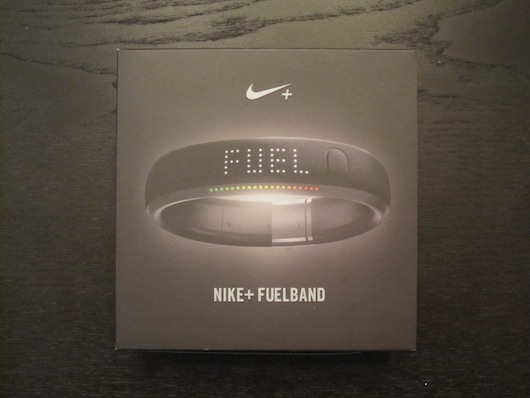
The idea is to encourage people to become more active through goals and positive reinforcement. I have been a Nike+ advocate for several years, so I thought I would try the FuelBand. Here are my thoughts after a couple weeks of use.
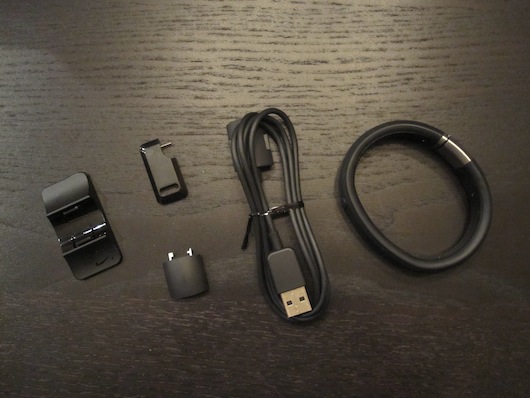
The package includes the following: Nike+ FuelBand, sizing extenders (0.32 in and 0.63 in), a sizing tool, a USB charging cable, and a USB stand.
The FuelBand contains a three-axis accelerometer that measures your motion in space. Using a proprietary algorithm, Nike correlates that motion with oxygen intake. That information is then used to calculate a universal number for users to track - fuel. Users then create a daily goal for the amount of fuel they want to earn.1
In addition to fuel, the band will track duration of activity and calculate estimated steps, distance traveled, and calories burned.
There are limitations to the FuelBand’s capabilities. Since the it relies on an accelerometer, activities in which a person’s arm remains stable are not accurately tracked. For example, riding a bicycle, doing pushups, or certain weight lifting routines. It also does not offer GPS-based run tracking2 or heart rate monitoring.
The FuelBand is made with soft rubber and features rounded edges. The result is an extremely comfortable device. One can easily forget they are wearing the band.
The display consists of 120 LEDs whose brightness is controlled with an ambient light sensor. The band will show a user’s fuel, steps, calories burned, progress to reaching the daily goal, and the time. That carousel of information is controlled via an unobtrusive button on the front face.
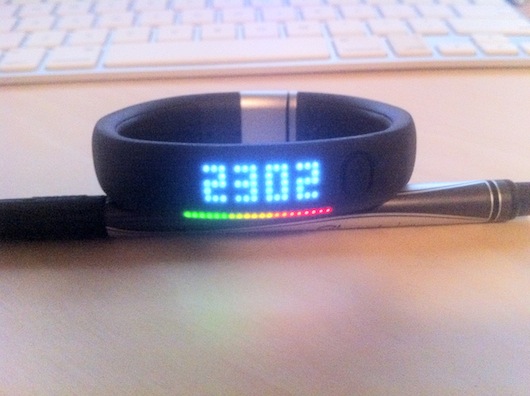
One end of the latch is actually a hidden USB plug. The charging cable connects to the band and can be used to transfer data or charge the device. While thin, the USB arm is extremely sturdy.
Nike claims that the FuelBand can operate up to four days on a single charge. This is in line with my own experiences. Generally, I had to charge the FuelBand on the fourth day of use. That is to say, battery life was never really a concern.
The FuelBand comes in three sizes: small (5.79" circumference), medium (6.77"), and large (7.76"). These sizes are easily adjusted using the included links.
Overall, the device is extremely lightweight with great build quality.
Nike offers two ways to sync activity data with your Nike+ account. The first is via USB with the free desktop FuelBand app. It simply detects the device and uploads the data to Nike. Users are then directed to the FuelBand website where they can view the data. The site displays single days, cumulative totals, trophies earned, and personal records.
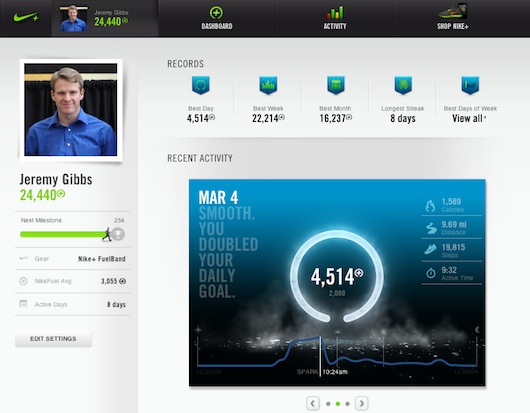
The second method is via Bluetooth with the free iOS FuelBand app.3 After an initial pairing process, the band will sync with the simple push of a button. In addition to displaying the current day’s activity, users can view all of the information available on the website and easily share their progress on Twitter or Facebook.
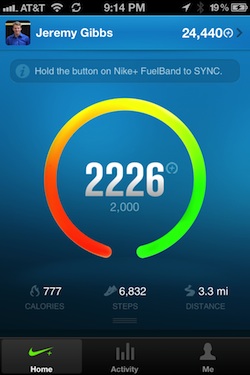
Let’s start with the negatives. Firstly, it is pricey at $149 - however, I will later explain why I found it worth the money. Secondly, I found the accuracy of the estimated distance to be lacking. For instance, this weekend I went on a 10-mile walk with my wife, yet the FuelBand reported a daily distance of only 8 miles. Thirdly, and perhaps related, is that stairs are not accurately handled. As an example, walking from the first to fifth floors at work resulted in a step count that was only one-third of the actual number taken. I suspect that Nike is still fine-tuning their accelerometer algorithms and will release fixes in future firmware updates.
Despite these drawbacks, I am overall pleased with the Nike+ FuelBand after a couple weeks of use. The FuelBand is extremely lightweight and comfortable, as opposed to other similar devices that are bulky and awkward to wear. The device is easy to use and syncing is simple. Users are presented with beautiful and fun feedback that encourages activity.
Perhaps the best evidence I can offer for the use of the FuelBand is anecdotal. Working with computers everyday, I have a very sedentary job. I have to make a concerted effort to reach my daily fuel goal. Last week, I was still 400 short of my goal at 9 p.m. In the past, I would have been content with watching television, but instead my wife suggested we go on a walk so that I could reach my goal. So we went out and walked around the neighborhood for almost an hour. Not only did I exercise when I normally wouldn’t have, I was able to spend quality time with my wife that might have otherwise been wasted on television or the internet.
That takes me back to the price. One the face of it, $149 seems expensive for what you get - an activity monitor that tracks steps, estimates calories burned, and displays time. You might be tempted to call it a glorified pedometer. However, for myself, the Nike+ FuelBand has proven its value.
The main reason is that the device has encouraged me to increase my daily activity and get outside. It shone a light on how little I might do otherwise. Sure the device is high quality, but the ancillary perks are of equal value. Nike has really created an awesome integrated workout environment with Nike+ and the FuelBand. The attention to aesthetic, detail, and user interaction has led to a great experience.
Plus, I trust Nike much like I do Apple. If something goes wrong, I am positive they will make it right. More importantly, I am confident that this isn’t a fly-by-night venture meant to squeeze money out of people. Nike has shown a commitment to their Nike+ ecosystem and it is apparent that they are planning for the future. That peace of mind is worth the money alone.
When considering whether to buy the FuelBand, you must remember what purposes it does and doesn’t fulfill. It is not a fully-inclusive health system that will monitor your heart, track your GPS coordinates, and make you lunch. It is designed as a subtle encouragement to remain engaged in life. By using a universal activity metric, everyone can compete with one another. More importantly, it forces you to compete with yourself.
If you can afford $149 and would like a way to challenge yourself, I suggest giving the Nike+ FuelBand a try. Personally, I recommend using it in conjunction with their $1.99 Nike+ GPS app and immerse yourself in the Nike+ ecosystem. Oh, and get active!
2,000 is considered a normal day while 4,000 is an active day. ↩︎
The Nike+ GPS app serves this purpose. ↩︎
Nike is currently working on an Android version. ↩︎
NPR’s new public ethics handbook:
At all times, we report for our readers and listeners, not our sources. So our primary consideration when presenting the news is that we are fair to the truth. If our sources try to mislead us or put a false spin on the information they give us, we tell our audience. If the balance of evidence in a matter of controversy weighs heavily on one side, we acknowledge it in our reports. We strive to give our audience confidence that all sides have been considered and represented fairly.
Did you catch the really important part? If the balance of evidence in a matter of controversy weighs heavily on one side, we acknowledge it in our reports.
What NPR is saying is that fairness is only owed to the truth and not to any particular side of a story. For instance, NPR would not devote equal time to people who claim that allowing babies to smoke cigarettes is responsible.1 Why? Because that side is so extreme that equal inclusion belies its truth.
The next time that you laud a news organization for being “fair and balanced”, consider that one side may actually be artificially propped up on the seesaw of reality. I firmly believe this country would be better informed if fairness was directed at truth and not loud voices. Kudos to NPR.
Climate change comes to mind as another great example of skewing the truth through fairness. ↩︎
Luke Wroblewski:
From the number of smartphone users in the United States to native mobile app use, the fifty percent line is approaching or already crossed.
Horace Dediu previously estimated that mobile penetration in the U.S. would reach 50% by the end of September 2012. Wroblewski compiles several metrics to show that the milestone is well on pace, if not ahead of schedule.
It seems the main limiting factors on growth in the U.S. will be economics or sparsity of broadband mobile data. Even then, imagine the mobile industry in another year or two. It won’t be long before most people are using smartphones and accessing a majority of their data in a mobile environment.
Daniel Rutter on the myth that sugar itself causes hyperactivity in children:
Yes, your doctor is right. There’s no such thing as a sugar rush. Sugar is not a stimulant, whether it’s glucose, sucrose, the High-Fructose Corn Syrup that continues to rain stickily down on the entire population of North America, or any of the other sweet-tasting whatever-oses.
My wife, a pediatrician, has ranted about this for some time. As Rutter notes, sweets create a placebo effect. The effect, however, often happens to the parent, not the child.
That said, I’ll probably continue to act obnoxious when eating a cupcake.
Mark Wilson:
Some have claimed the “yo momma” (also known as “yo mama”) joke has come and gone, its subtle deconstruction of the triad relationship between one’s mom, one’s mom’s personal aesthetic or intelligence, and one’s insulter having peaked some time in the early ’90s.
At least two people disagree. One person is me.
Better make it a third.
Patrick Marsh:
I firmly believe the NWS is standing on a precipice, and the entire meteorological community needs to take a moment and figure things out before it’s too late. This presentation is designed to start a conversation; let the discussion begin!
A timely presentation on the current state of National Weather Service tornado emergencies. Highly recommended.
John Gingerich:
But experience has also taught me that readers, for better or worse, will approach your work with a jaundiced eye and an itch to judge. While your grammar shouldn’t be a reflection of your creative powers or writing abilities, let’s face it — it usually is.
I found this article to be impactful.1
See what I did there? ↩︎
Geeta Dayal:
Two Japanese researchers recently introduced a prototype for a device they call a SpeechJammer that can literally “jam” someone’s voice — effectively stopping them from talking. Now they’ve released a video of the device in action.
“We have to establish and obey rules for proper turn-taking,” write Kazutaka Kurihara and Koji Tsukada in their article on the SpeechJammer. “However, some people tend to lengthen their turns or deliberately disrupt other people when it is their turn … rather than achieve more fruitful discussions.”
Session Chairs at scientific meetings should be equipped with one of these. If a speaker exceeds their allotted time - speech jammed. Likewise, if an audience member poses a dumbass question - “I’m sorry, I can’t hear you.”
Brian Vastag, The Washington Post:
Archaeologists have long held that North America remained unpopulated until about 15,000 years ago, when Siberian people walked or boated into Alaska and then moved down the West Coast.
But the mastodon relic found near the mouth of the Chesapeake Bay turned out to be 22,000 years old, suggesting that the blade was just as ancient.
Whoever fashioned that blade was not supposed to be here.
Smithsonian Institution anthropologist Dennis Stanford, along with colleagues, hypothesize that the first Americans may have originated from Europe - not Asia. A very interesting read.